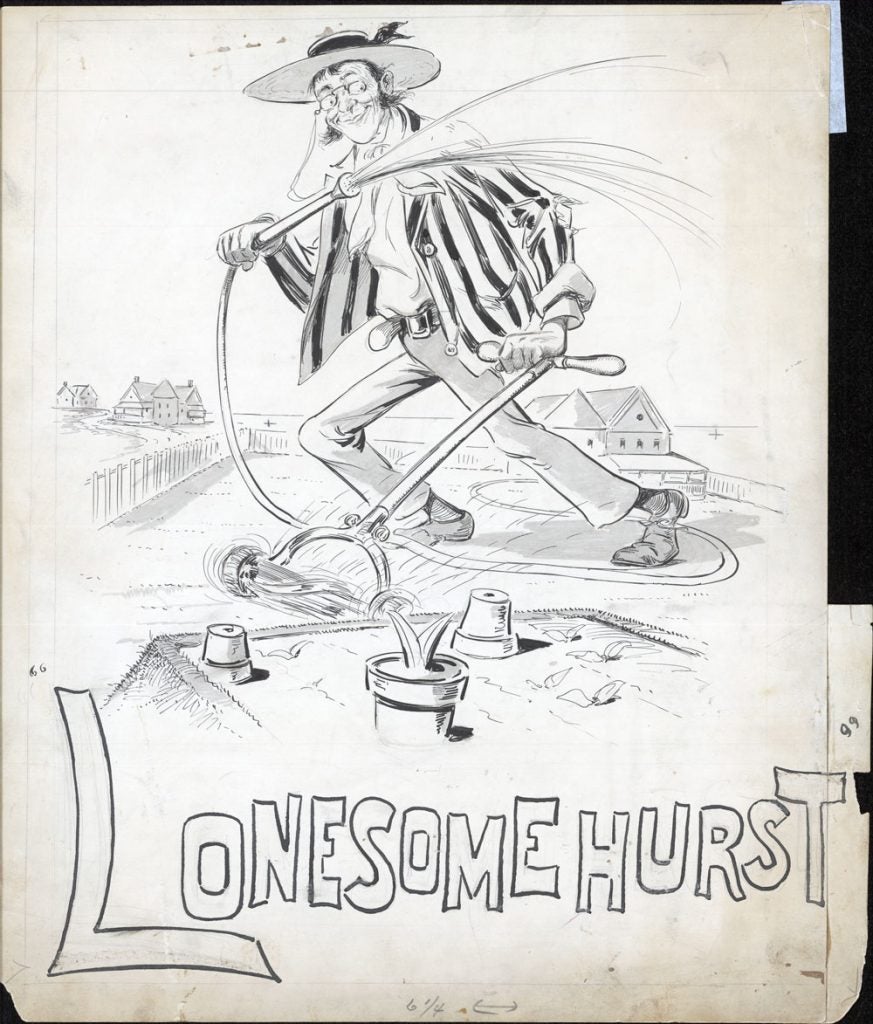

“Lonesomehurst” (“Puck’s Library,” Cover, August 1894)
by Charles Jay “CJ” Taylor (1855-1929)
14 x 16 inches, ink on board
Coppola Collection
Taylor originally studied law at Columbia University, then moved to art at the Art Students League, the National Academy of Design (with Eastman Johnson) and City College of New York, as well as in London and Paris. Taylor painted hundreds of landscape pictures in oil, which he sold to dealers and at auction. He started contributing illustrations to the New York’s Daily Graphic in 1873, and also to magazines such as Harpers, Puck and Punch.
His book ‘Taylor Girls’ gained him international acclaim. He returned to painting in the later part of his life, and spent 18 years as the head of the Painting and Decoration Department in the College of Fine Arts at the Carnegie Institute of Technology (the Carnegie Alma Mater song is his composition).
Started as a German language publication, the first issue of “Puck” in English appeared in March 1877: 16 pages for 10 cents. Readers liked the cartoon satires, which were rare in American periodicals at that time. The magazine was named for William Shakespeare’s character, Puck, in Midsummer Night’s Dream: “What fools these mortals be!”
Its popularity and circulation soared, reaching nearly 90,000 subscribers in the 1890s. Spin-off publications were created, such as “Puck’s Library” and “Pickings from Puck.” The Hearst conglomerate purchased “Puck” in 1917 and replaced the hard-hitting political commentary with a focus on the fine arts and social fads. Declining subscriptions resulted in Hearst’s decision to discontinue “Puck” in September 1918.
Now, about this “Lonesomehurst” word.
There is a large number of streets in the UK whose names end in -hurst, for example, Ravenhurst,Gathurst, Oakhurst, Amhurst, Bonehurst, Eaglehurst… It’s a Saxon word meaning, roughly, a identifiable hill with a wooded or bushy eminence. A sense of place that is isolated and associated with something.
In the 1890s, “lonesomehurst” was used to refer to the new phenomenon of single-family homes sitting at the outskirts of cities. In other words: the suburbs. In a 1901 book by Joseph Fitzgerald (“Word and Phrase”), he describes an origin of the word (although it’s clearly something that was in use, given the August 1894 cover date on the issue that carries this cartoon, so this counts as apocryphal).
“The unusual violence of the wind and snowstorms of February, 1895, caused great suffering and loss of life among mariners and landfolk on the Atlantic coast, and throughout the country; and the newspaper chroniclers presented, some of them, marvelously realistic pictures of the scenes of devastation. One of these scribes, in telling of a burial at sea, coined, or at least employed a singularly apt and telling phrase: **They dropped the dead babies into the yawn of the sea.” Very happy, too, was the name, apparently coined for that occasion, to express the forlorn situation of outlying new suburbs, when cut off by such a visitation from their mother city and place of occupation, — Lonesomehurst.”
Thanks to the Internet of All Things, you can find out that the first single-family house built in Garden City, NJ (in the mid-1890s, at the corner of Cathedral and, which is still there) was called Lonesomehurst.
This all gives the 1894 cover its meaning, as this guy is doing the chores of his suburban home ownership, with the widely separated neighbors showing in the distance. Eighty years later, people would still be singing about life in the suburbs:
The local rock group down the street
Is trying hard to learn their song
They serenade the weekend squire
Who just came out to mow his lawn
Another pleasant valley Sunday
Charcoal burning everywhere
Another pleasant valley Sunday
Here is Status Symbol Land
Songwriters: Carol King/Gerry Goffin
Singers: The Monkees


